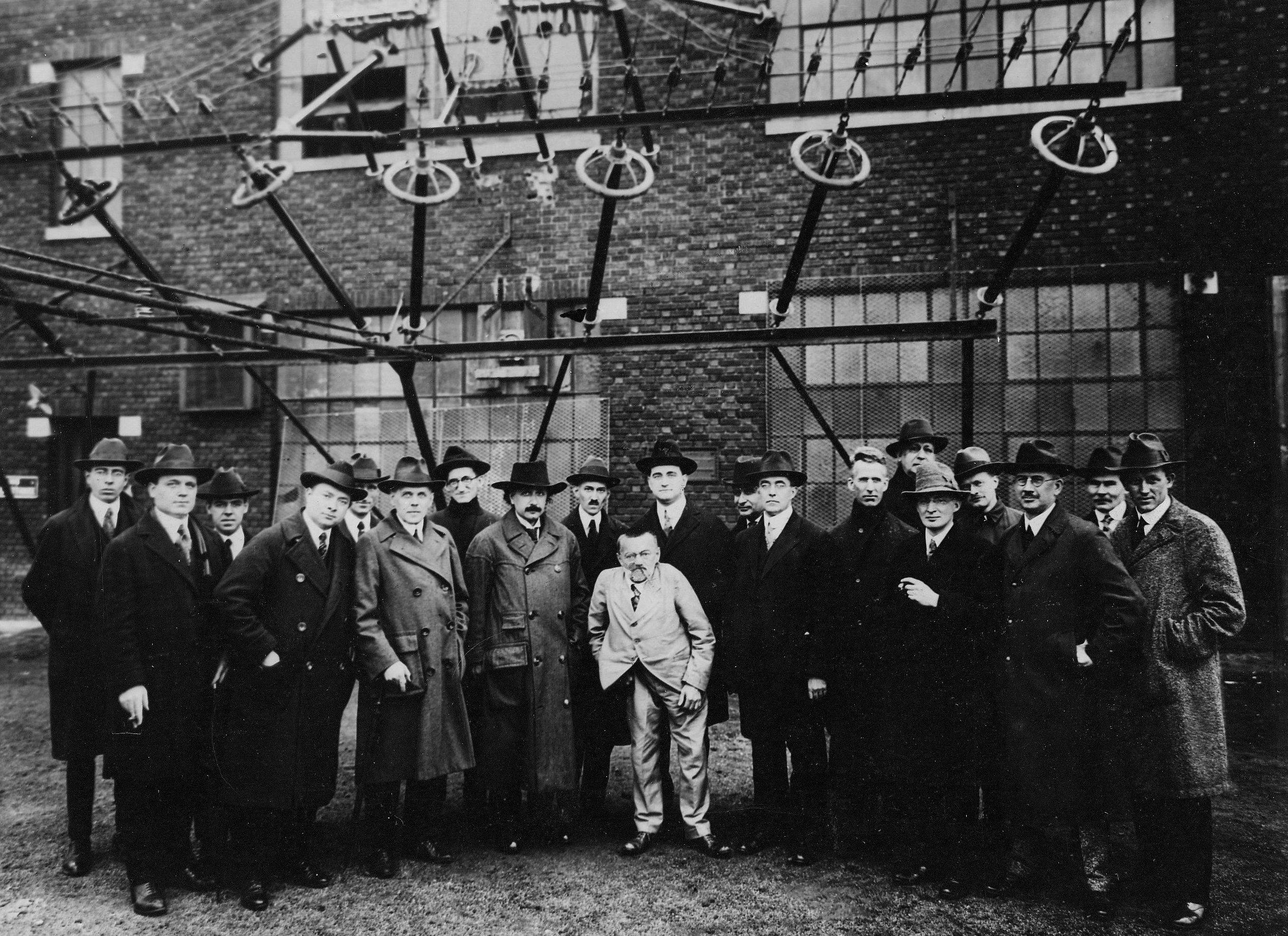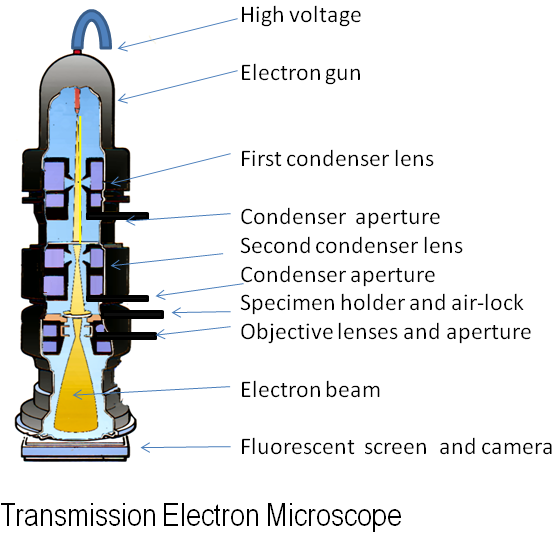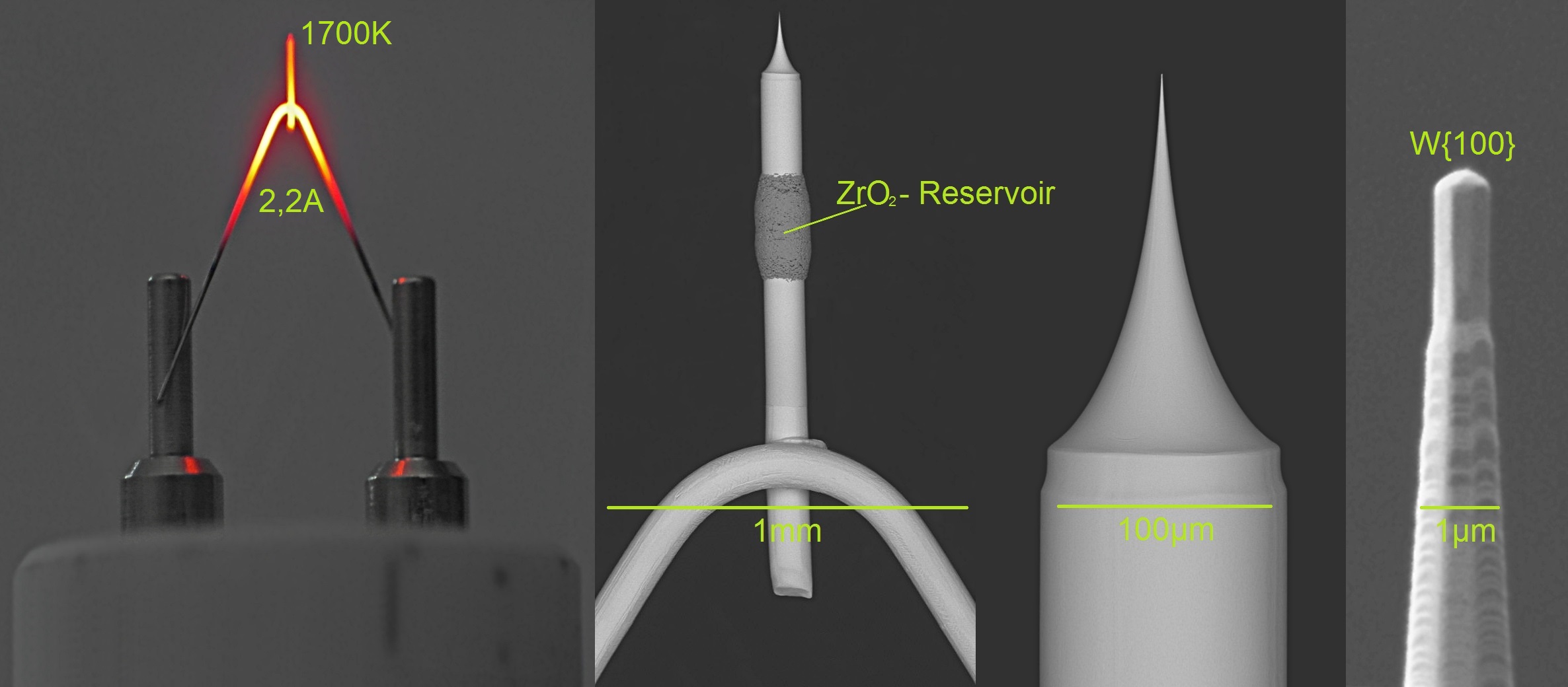|
Edward Ramberg
Edward Granville Ramberg (June 14, 1907 – January 9, 1995) was an American physicist who contributed to the early development of electron microscopy and color television. He was the uncle of Mario Capecchi, a 2007 Nobel laureate. Life and education Ramberg was born in Florence, Italy to American painter, Lucy Ramberg (née Dodd), and father Walter Gustave Ramberg a German archaeologist. Ramberg and his family (he had two older siblings, Walter Gustav Charles Ramberg and Lucy Elizabeth Ramberg) lived in a villa in Florence until the outbreak of World War I putting Germany and Italy on different sides. The family evacuated to Munich where the father was drafted into the German army and was killed in action. After the war, the mother took the family to her family home in Portland, Oregon but she and her daughter returned to the family villa in Florence as Europe returned to normal after the war. While in Portland, Ramberg graduated from Lincoln High School in 1922. T ... [...More Info...] [...Related Items...] OR: [Wikipedia] [Google] [Baidu] |
Electron Microscopy
An electron microscope is a microscope that uses a beam of accelerated electrons as a source of illumination. As the wavelength of an electron can be up to 100,000 times shorter than that of visible light photons, electron microscopes have a higher resolving power than light microscopes and can reveal the structure of smaller objects. A scanning transmission electron microscope has achieved better than 50 pm resolution in annular dark-field imaging mode and magnifications of up to about 10,000,000× whereas most light microscopes are limited by diffraction to about 200 nm resolution and useful magnifications below 2000×. Electron microscopes use shaped magnetic fields to form electron optical lens systems that are analogous to the glass lenses of an optical light microscope. Electron microscopes are used to investigate the ultrastructure of a wide range of biological and inorganic specimens including microorganisms, cells, large molecules, biopsy samples, ... [...More Info...] [...Related Items...] OR: [Wikipedia] [Google] [Baidu] |
Quakers
Quakers are people who belong to a historically Protestant Christian set of denominations known formally as the Religious Society of Friends. Members of these movements ("theFriends") are generally united by a belief in each human's ability to experience the light within or see "that of God in every one". Some profess a priesthood of all believers inspired by the First Epistle of Peter. They include those with evangelical, holiness, liberal, and traditional Quaker understandings of Christianity. There are also Nontheist Quakers, whose spiritual practice does not rely on the existence of God. To differing extents, the Friends avoid creeds and hierarchical structures. In 2017, there were an estimated 377,557 adult Quakers, 49% of them in Africa. Some 89% of Quakers worldwide belong to ''evangelical'' and ''programmed'' branches that hold services with singing and a prepared Bible message coordinated by a pastor. Some 11% practice ''waiting worship'' or ''unprogramme ... [...More Info...] [...Related Items...] OR: [Wikipedia] [Google] [Baidu] |
Institute Of Radio Engineers
The Institute of Radio Engineers (IRE) was a professional organization which existed from 1912 until December 31, 1962. On January 1, 1963, it merged with the American Institute of Electrical Engineers (AIEE) to form the Institute of Electrical and Electronics Engineers (IEEE). Founding Following several attempts to form a technical organization of wireless practitioners in 1908–1912, the Institute of Radio Engineers (IRE) was finally established in 1912 in New York City. Among its founding organizations were the Society of Wireless Telegraph Engineers (SWTE) and the Wireless Institute (TWI). At the time, the dominant organization of electrical engineers was the American Institute of Electrical Engineers (AIEE). Many of the founding members of IRE considered AIEE too conservative and too focused on electric power. Moreover, the founders of the IRE sought to establish an international organization (unlike the “American” AIEE), and adopted a tradition of electing some of ... [...More Info...] [...Related Items...] OR: [Wikipedia] [Google] [Baidu] |
Society For Information Display
The Society for Information Display (SID) is an industry organization for displays, generally electronic displays such as televisions and computer monitors. SID was founded in September 1962. Its main activities are publishing technical journals and running "Display Week", its main conference, held in May or June each year. SID publications include the ''Journal of the Society for Information Display'', published monthly, the ''Digest of Technical Papers'' from SID's annual conference, ''Information Display'' magazine, proceedings from other conferences such as the Vehicle Displays and Interfaces Symposium, Asia Display, and International Display Workshops. In addition, local chapters in the Americas, Europe, and throughout Asia have meetings frequently, including lectures by display technologists, and are sometimes offered as webcasts. The SID Board of Directors grants several SID awards based upon outstanding achievements and significant contributions. History In early 1960s, I ... [...More Info...] [...Related Items...] OR: [Wikipedia] [Google] [Baidu] |
Karl Ferdinand Braun Prize
Karl Ferdinand Braun (; 6 June 1850 – 20 April 1918) was a German electrical engineer, inventor, physicist and Nobel laureate in physics. Braun contributed significantly to the development of radio and television technology: he shared the 1909 Nobel Prize in Physics with Guglielmo Marconi "for their contributions to the development of wireless telegraphy", was a founder of Telefunken, one of the pioneering communications and television companies, and has been both called the "father of television" (shared with inventors like Paul Gottlieb Nipkow) and the co-father of the radio telegraphy, together with Marconi. Biography Braun was born in Fulda, Germany, and educated at the University of Marburg and received a PhD from the University of Berlin in 1872. In 1874, he discovered that a point-contact metal–semiconductor junction rectifies alternating current. He became director of the Physical Institute and professor of physics at the University of Strassburg in 1895. In 1897 ... [...More Info...] [...Related Items...] OR: [Wikipedia] [Google] [Baidu] |
Institute Of Electrical And Electronics Engineers
The Institute of Electrical and Electronics Engineers (IEEE) is a 501(c)(3) professional association for electronic engineering and electrical engineering (and associated disciplines) with its corporate office in New York City and its operations center in Piscataway, New Jersey. The mission of the IEEE is ''advancing technology for the benefit of humanity''. The IEEE was formed from the amalgamation of the American Institute of Electrical Engineers and the Institute of Radio Engineers in 1963. Due to its expansion of scope into so many related fields, it is simply referred to by the letters I-E-E-E (pronounced I-triple-E), except on legal business documents. , it is the world's largest association of technical professionals with more than 423,000 members in over 160 countries around the world. Its objectives are the educational and technical advancement of electrical and electronic engineering, telecommunications, computer engineering and similar disciplines. History Origins ... [...More Info...] [...Related Items...] OR: [Wikipedia] [Google] [Baidu] |
David Sarnoff
David Sarnoff (February 27, 1891 – December 12, 1971) was an American businessman and pioneer of American radio and television. Throughout most of his career, he led the Radio Corporation of America (RCA) in various capacities from shortly after its founding in 1919 until his retirement in 1970. He ruled over an ever-growing telecommunications and media empire that included both RCA and NBC, and became one of the largest companies in the world. Named a Reserve Brigadier General of the Signal Corps in 1945, Sarnoff thereafter was widely known as "The General." Sarnoff is credited with ''Sarnoff's law'', which states that the value of a broadcast network is proportional to the number of viewers. Early life and career David Sarnoff was born to a Jewish family in Uzlyany, a small town in the Russian Empire, now part of Belarus, the son of Abraham Sarnoff and Leah Privin. Abraham emigrated to the United States and raised funds to bring the family. Sarnoff spent much of his early c ... [...More Info...] [...Related Items...] OR: [Wikipedia] [Google] [Baidu] |
American Physical Society
The American Physical Society (APS) is a not-for-profit membership organization of professionals in physics and related disciplines, comprising nearly fifty divisions, sections, and other units. Its mission is the advancement and diffusion of knowledge of physics. The society publishes more than a dozen scientific journals, including the prestigious '' Physical Review'' and ''Physical Review Letters'', and organizes more than twenty science meetings each year. APS is a member society of the American Institute of Physics. Since January 2021 the organization has been led by chief executive officer Jonathan Bagger. History The American Physical Society was founded on May 20, 1899, when thirty-six physicists gathered at Columbia University for that purpose. They proclaimed the mission of the new Society to be "to advance and diffuse the knowledge of physics", and in one way or another the APS has been at that task ever since. In the early years, virtually the sole activity of the AP ... [...More Info...] [...Related Items...] OR: [Wikipedia] [Google] [Baidu] |
Darmstadt
Darmstadt () is a city in the States of Germany, state of Hesse in Germany, located in the southern part of the Frankfurt Rhine Main Area, Rhine-Main-Area (Frankfurt Metropolitan Region). Darmstadt has around 160,000 inhabitants, making it the fourth largest city in the state of Hesse after Frankfurt am Main, Wiesbaden, and Kassel. Darmstadt holds the official title "City of Science" (german: link=no, Wissenschaftsstadt) as it is a major centre of scientific institutions, universities, and high-technology companies. The European Organisation for the Exploitation of Meteorological Satellites (EUMETSAT) and the European Space Operations Centre (ESOC) are located in Darmstadt, as well as Gesellschaft für Schwerionenforschung, GSI Centre for Heavy Ion Research, where several chemical elements such as bohrium (1981), meitnerium (1982), hassium (1984), darmstadtium (1994), roentgenium (1994), and copernicium (1996) were discovered. The existence of the following elements were also ... [...More Info...] [...Related Items...] OR: [Wikipedia] [Google] [Baidu] |
Technische Hochschule
A ''Technische Hochschule'' (, plural: ''Technische Hochschulen'', abbreviated ''TH'') is a type of university focusing on engineering sciences in Germany. Previously, it also existed in Austria, Switzerland, the Netherlands (), and Finland (, ). In the 1970s (in Germany) and the 1980s (in the Netherlands), the ''Technische Hochschule'' emerged into the (German) or (Dutch). Since 2009, several German universities of applied sciences were renamed as . Terminology In German-language countries, the term ''Hochschule'' is more general than ''Universität'' (plural: ''Universitäten'') and also encompasses universities which do not have the right to confer doctorates and habilitations, in contrast to ''Universitäten''. Today, ''Universitäten'' as well as other ''Hochschulen'' call themselves ''Technische Hochschule'' for historical reasons. However, a ''Technische Hochschule'' with the status of a ''Universität'' is regarded as a ''Technische Universität'' despite the name. ... [...More Info...] [...Related Items...] OR: [Wikipedia] [Google] [Baidu] |
Electron Microscope
An electron microscope is a microscope that uses a beam of accelerated electrons as a source of illumination. As the wavelength of an electron can be up to 100,000 times shorter than that of visible light photons, electron microscopes have a higher resolving power than light microscopes and can reveal the structure of smaller objects. A scanning transmission electron microscope has achieved better than 50 pm resolution in annular dark-field imaging mode and magnifications of up to about 10,000,000× whereas most light microscopes are limited by diffraction to about 200 nm resolution and useful magnifications below 2000×. Electron microscopes use shaped magnetic fields to form electron optical lens systems that are analogous to the glass lenses of an optical light microscope. Electron microscopes are used to investigate the ultrastructure of a wide range of biological and inorganic specimens including microorganisms, cells, large molecules, biopsy samples, ... [...More Info...] [...Related Items...] OR: [Wikipedia] [Google] [Baidu] |
Field Electron Emission
Field electron emission, also known as field emission (FE) and electron field emission, is emission of electrons induced by an electrostatic field. The most common context is field emission from a solid surface into a vacuum. However, field emission can take place from solid or liquid surfaces, into a vacuum, a fluid (e.g. air), or any non-conducting or weakly conducting dielectric. The field-induced promotion of electrons from the valence (chemistry), valence to conduction band of semiconductors (the Zener effect) can also be regarded as a form of field emission. The terminology is historical because related phenomena of surface photoeffect, thermionic emission (or Richardson–Dushman effect) and "cold electronic emission", i.e. the emission of electrons in strong static (or quasi-static) electric fields, were discovered and studied independently from the 1880s to 1930s. When field emission is used without qualifiers it typically means "cold emission". Field emission in pure metal ... [...More Info...] [...Related Items...] OR: [Wikipedia] [Google] [Baidu] |






